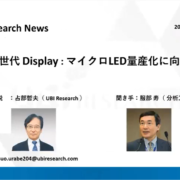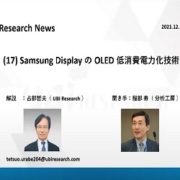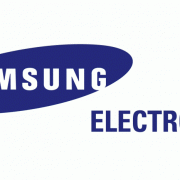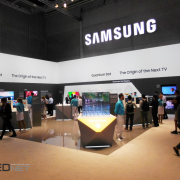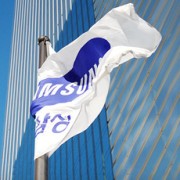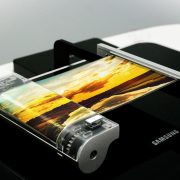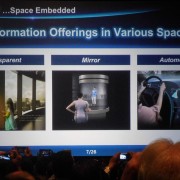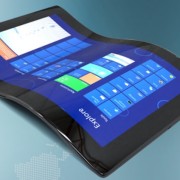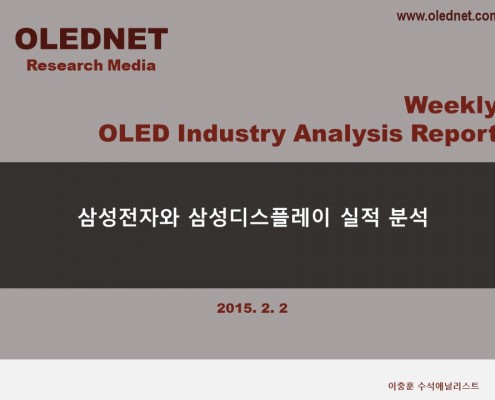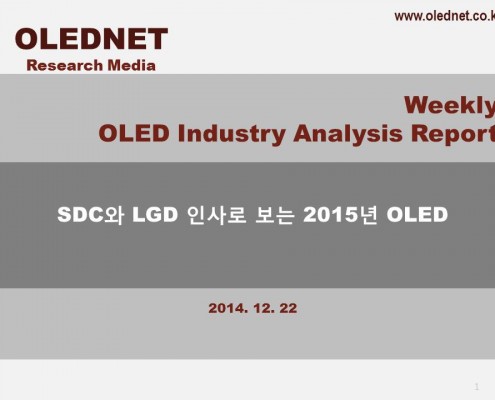投稿
サムスンの有機ELディスプレイの低消費電力技術
/カテゴリ: Oled Video, ディスプレイ, フォーカス・オン /作成者: OLEDNETサムスンの有機ELディスプレイの低消費電力技術
Samsung Electronics、2018年第2四半期ディスプレイ事業の営業利益 1,400億ウォンを記録
/カテゴリ: ディスプレイ, フォーカス・オン /作成者: Daejeong YOONSamsung Electronicsは7月31日に行われた2018年4~6月(第2四半期)の決算カンファレンスコールで、売上高は58兆4,800億ウォン、営業利益は14兆8,700億ウォンを記録したと発表した。前年同期比売上高は4%減少し、営業利益は8,000億ウォン増加した。前四半期比売上高は3%、営業利益は8,000億ウォンの減少となった。
Samsung Electronicsによると、ディスプレイパネル事業はフレキシブルOLEDパネルの需要鈍化とLCD TVパネルの販売減少で、実績も減少し、売上高は5兆6,700億ウォン、営業利益は1,400億ウォンとなった。OLED部門はリジッドOLEDの稼働率が向上したのにも関わらず、フレキシブル製品の需要減少が続き、前四半期に比べて実績が減少した。
下半期にはリジッドOLEDとLTPS LCDの競争が激しくなると予想されるが、フレキシブル製品の需要回復による販売拡大で、実績も改善される見込みである。AppleのiPhone新モデル用フレキシブルOLEDを第2四半期から生産開始し、下半期には売上高と営業利益が改善されると見込まれる。
Samsung Electronicsは差別化された技術力とコスト競争力を強化することで、モバイルOLEDの市場シェアを拡大し、Foldable OLEDなど、新規製品群の力量を高める計画だ。Foldable OLEDは、下半期実績よりは来年以降の成長に貢献すると予想される。
ITやモバイル(IM)部門の第2四半期売上高は24兆ウォン、営業利益は2兆6,700億ウォンを記録した。営業利益は前年同期の4兆600億ウォンに比べ34.2%減少し、前四半期の3兆7,700億ウォンよりも大きく減少した。第2四半期携帯電話の販売量は7,800万台で、このうち90%がスマートフォンである。タブレットは500万台販売された。端末の平均販売価格(ASP)は220米ドル台後半である。
消費者家電(CE)部門の第2四半期売上高は、10兆4,000億ウォン、営業利益は5,100億ウォンを記録した。上半期全体の売上高は20兆1,400億ウォン、営業利益は7,900億ウォンである。グローバルスポーツイベントという特殊な状況の中で、QLED TVなどの高付加価値製品の販売好調によって、TVの利益が向上した。
一方、Samsung Electronicsの第2四半期施設投資規模は8兆ウォンだった。事業別には半導体が6兆1,000億ウォン、ディスプレイが1兆1,000億ウォン程度である。上半期の累計では、半導体が13兆3,000億ウォン、ディスプレイが1兆9,000億ウォンなど、総計16兆6,000億ウォンが投資された。
[IFA2016] サムスン電子のテレビ展示、コンセプトは?
/0 コメント/カテゴリ: セット, フォーカス・オン /作成者: oled「IFA2016」に設けられたサムスン電子のテレビブースは従来とは非常に違ったところがある。
現在市販されている液晶テレビには、LEDバックライトを使用する既存のテレビと、量子ドットシート(quantum dot sheet)を使用するSUHDテレビの2種類がある。ところが、当社ブースで広い展示エリアを占めながら紹介されている製品は、まだいつ世に出るか分からない量子ドットディスプレイを使用する「inorganicテレビ」。

サムスン電子が実物のテレビ製品に代わって紹介した概念的な「inorganicテレビ」は、有機ELテレビより遥かに優れた性能をもつ製品だ。有機ELテレビを表す「organic」は時間の経過とともに輝度が急激に低下し、テレビとしての機能を完全に失ってしまうが、「inorganic」は殆ど変化がない。これが事実だとすれば、永遠に使えそうな優れた製品だ。

また別の概念展示でサムスン電子は、「Inorganicテレビ」の色純度がずば抜けて優れていることを示した。



「Organicテレビ」の光源から放射される光はRGBがとても曖昧だ。これに対して、「inorganicテレビ」は生まれながらに明確なRGBで始まる。この光がカラーフィルタに届く前から既に「inorganic」は独立した波長と強度を形成しているが、「organic」は色が分離されていない曖昧な光になっている。ここで見られる「inorganicテレビ」の構造は、液晶とカラーフィルタの間に量子ドットを挿入した形になっている推定される。最後に、カラーフィルタを通過した「organic」の光は、青と緑赤が混ざっている2波長の光を3波長の光に変換させたものであるため、三原色の色純度が低いという。これに対して、「inorganic」はカラーフィルタに届く前からずっと色純度の高い光をより強く外へ放している。
この2つの展示内容が事実だとしたら、サムスン電子は実に物凄い次世代テレビを準備していることになる。
問題はこの技術はまだ誕生していない、お母さんのお腹の中にもいない、全くの概念に過ぎないものだというのが、来場者からの指摘だ。何が起きるか分からない未知の世界についてあまりにも正確に堂々と描写するサムスン電子の姿は、逆説的に未来のテレビに対する準備が全くできていないかのように受け取られている。
さらに、有機ELテレビを、現在市販されているSUHDテレビと比較せず、未来のテレビ技術と比較したことで、量子ドットを使用するSUHDテレビより有機ELテレビの方が優秀だということを間接的に認めたことになる。
サムスン電子は「IFA2016」での展示を通じて、SUHDテレビが今後も成長し続けるということをアピールし、近いうちに有機ELテレビは消えるということを示そうとした。だが、現状としては有機ELテレビの方がSUHDテレビより優れているため、未来の「inorganicテレビ」と比較するしかない。返って、その緊迫な状況を自認してしまった。
最後の一言、液晶テレビにどんなことをしても「black」は無理。液晶だから。
サムスンディスプレイ、20〜30k Gen5.5 rigid 有機ELラインの増設急ぐ…中国の需要爆発
/0 コメント/カテゴリ: ディスプレイ, 市場, 装備 /作成者: OLEDNET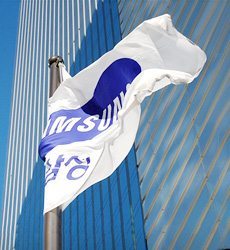
Picture Source = SDC
Hyunjoo Kang / jjoo@olednet.com
サムスンディスプレイ5世代有機ELライン増設が必要であると分析される。
サムスンディスプレイが急増している有機ELスマートフォンの需要に対応するためにはGen5.5 rigid 有機ELラインの追加増設と、V1ラインの移設が避けられないものと分析される。
現在、中国のスマートフォン用有機EL需要は爆発的である。UBIリサーチの調査によると、中国で来年までに必要とする量は2億枚にも達する。
したがって、サムスンディスプレイはA2工場でより多くの有機ELパネルを生産するために、透明有機ELを製造するV1ラインをLCD用Gen8の工場であるL8に移動する必要があると判断される。
有機EL用V1ラインはGen8装置で製造されたTFT基板を6分割して使用してきたので、V1ラインをこのGen8の工場に移転することがパネルの生産と物流管理のうえで最も望ましいものと考えられる。
UBIリサーチのイ・チュンフン代表は、「中国の今後のモバイル有機ELの需要はBOEなど、中国の主要パネルメーカーが供給するには不可能な量であることはもちろん、サムスンディスプレイでも現存する量産ラインでは、十分な供給が容易ではない」とし、 「このためにサムスンディスプレイは、少なくともGen5.5のA2ラインに20~30k規模の有機EL量産ラインの増設が必要になるであろう」と予想した。
「サムスンディスプレイ、有機EL量産拡大に8兆ウォン投資」
/0 コメント/カテゴリ: ディスプレイ, フォーカス・オン /作成者: oled
出典= Samsung Display
サムスンディスプレイが、今年有機EL量産設備拡大のために約8兆ウォンを投入する予定であると、18日日本の日経新聞が報じた。
報道によると、サムスンディスプレイは忠清南道湯井工場の有機EL量産設備を拡充する予定である。8兆ウォンの投資は、サムスンディスプレイの昨年の投資に達する金額で、スマートフォン用パネル2億数千万枚分に相当する規模である。これは、現在の生産能力の50%を超えると日経は報じた。
サムスンディスプレイのこのような動きは、Appleや中国企業に有機ELを供給するための準備であると見られる。サムスンの大型投資は有機ELパネル市場をほぼ独占しようとする計画で、これはパネル生産競合他社への脅威になるであろうというのが日経の分析である。
一方、Appleは、2018年に有機ELスマートフォン発売方針を部品メーカーに伝えたが、一部の機種は来年に短縮される計画と知られている。
Samsung’s 806 ppi AMOLED, to Synergize both VR and Smartphone
/0 コメント/カテゴリ: セット /作成者: OLEDNET
SDC`s 806 ppi OLED Panel for VR
Hyunjoo Kang / jjoo@olednet.com
Samsung Display’s recently revealed 5.5 inch 806 ppi AMOLED is expected to contribute to the expansion of the global VR (virtual reality) market as well as providing synergy for both Samsung Electronics’ future VR and smartphone business.
In SID 2016 (22-27 May), Samsung Display revealed 5.5 inch AMOLED with resolution of 806 ppi. This 4K UHD display has the highest resolution for 5 inch mark AMOLED in industry.
The response speed of AMOLED is approximately 1,000 times faster than LCD and can actualize much superior picture quality due to exceptional contrast ratio. The reduced amount of harmful blue light is also another merit of AMOLED, and it is becoming the general trend for display for VR display.
Even at the same resolution, the visual effects for smartphone and VR device are different. For example, 577 ppi QHD resolution applied to Galaxy S7 can actualize quite clear picture quality for smartphone. However, when the display is directly in front of the eyes, in cases of VR, aliasing effects, when what is on the screen looks jagged, occurs. In order to produce clear picture quality with almost no aliasing effects in VR, expert believe that 1,500 ppi is required at minimum. However, the current VR AMOLED only can actualize up to high 500 mark ppi.
That Samsung Display displayed AMOLED with resolution of over 800 ppi for the first time should be noted. With this resolution, aliasing in VR can be significantly improved even if not perfectly. Furthermore, this AMOLED has the same brightness as the Samsung’s Galaxy S7. Considering the production yield improvement, this display could be used for Galaxy S8 (TBA) that is expected to be released in 2017. For VR device connected to smartphone, smartphone’s resolution is directly related to the VR’s picture quality. This means that the Samsung’s 806 ppi 5.5 inch AMOLED allows for UHD smartphone production as well as the introduction of VR with upgraded picture quality.
UBI Research explained that while some believe that ultra-high resolution is not necessary in small screen such as smartphone, the 4K UHD 5.5 inch AMOLED is significant in that smartphone is linked with VR which market is being opened. He added that the 806 ppi AMOLED recently revealed in SID 2016 by Samsung will contribute to the expansion of the global VR market as well as providing synergy for both Samsung Electronics’ future VR and smartphone business.
[SID 2016] Samsung Reveals 806 ppi VR Panel, Highest Resolution in Industry
/0 コメント/カテゴリ: 展示 /作成者: OLEDNET
SDC Showcasing an 806ppi OLED Panel for VR ( San Francisco = OLEDNET )
Hyunjoo Kang / jjoo@olednet.com
Samsung Display is drawing attention with 5 inch level VR (virtual Reality) device display with the highest resolution in the industry. The company also displayed Bio Blue, which minimized blue wavelength harmful to human eye.
At Society for Information Display 2016 ( SID 2016, 22-27 May), Samsung Display drew visitors’ attention with their new panel products such as OLED for VR and rollable OLED. At the exhibition booth, Samsung Display presented new 5.5 inch panel. The panel’s resolution, 806 ppi, is the highest pixel density of the 5 inch level VR panels published so far. The resolution is 3840 x 2160 with 306 nit brightness and 97% color gamut.

SDC`s ‘Bioblue’ (Sanfrancisco = OLEDNET)
Additionally, Samsung Display revealed another OLED panel for VR named Bio Blue. Bio Blue minimized harmful blue light by adding light blue to the existing RGB pixel structure. Displaying Bio Blue, the company emphasized that OLED is better for eye health compared to LCD. Of the total blue spectrum, the proportion of blue light harmful to human eye is 66% for LCD and 32% for AMOLED. Samsung Display added that AMOLED will be able to reduce this figure to 6% in future.
Samsung Display exhibited diverse OLED panels including 5.7 inch rollable and panel for notebook use.
[SID 2016] Samsung Display ’s EVP “The Future of Car, Window and Mirror is AMOLED”
/0 コメント/カテゴリ: 展示 /作成者: OLEDNET
a Slide from Samsung Display EVP`s Keynote at SID 2016 (San Francisco = OLEDNET)
Hyunjoo Kang / jjoo@olednet.com
As a keynote speaker for SID 2016, Samsung Display ’s Executive VP and Chief of Research Center, Dr. Sung-Chul Kim explained that display will expand human life experiences through application to automotive, window, mirror, etc. and emphasized that AMOLED will become a key solution for this.
During his keynote session in SID 2016, Kim explained display related technological issues and AMOLED’s advantages. In particular, he highlighted AMOLED’s characteristics suitable for flexible.
Displays that can turn from a wall or window into an information display simultaneously require flexibility and hardness. Kim also explained curved display is suitable for automotive uses. In terms of mirror display, AMOLED is suitable as superior color gamut is required.
Kim added that for realistic image required by VR (virtual reality) and others requires ‘driving tech’. He explained that foldable, rollable, deformable, and stretchable displays will produce more attractive devices, and provide new experiences through VR, automotive, digital signage, etc.
Kim told the attendees that display is a window to communicate with the world and expands lives. He emphasized that AMOLED is the key solution for future display, and will bring more opportunities than expected.
아이씨디( ICD ), 삼성디스플레이에 80억원 규모 AMOLED 장비 공급
/0 コメント/カテゴリ: 미분류 /作成者: OLEDNET
출처 = ICD
강현주 / jjoo@olednet.com
반도체용 기계 제조사인 아이씨디( ICD )가 23일 삼성디스플레이에 80억원 규모의 AMOLED 제조장비를 공급하기로 계약했다고 공시했다.
이번 계약금액은 약 80억3천900만원이며, 계약기간은 9월 30일까지다.
아이씨디는 자체 생산으로 해당 장비를 공급할 계획이다.
Portfolio Items
(株)ユビ産業リサーチ/ 取締役 イ・チュンフン / 事業者の登録番号 220-87-44660 / 通信販売業の届出番号: 江南-15333号
住所: A-1901, Samho Moolsan Bldg, 83, Nonhyeon-ro, Seocho-gu, Seoul, Republic of Korea (Zip) 06775 (株)ユビ産業リサーチ / TEL:02-577-4390 / E-MAIL:marketing@ubiresearch.com

